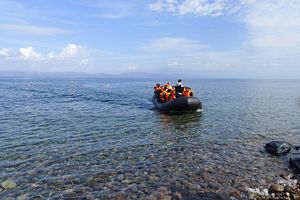“War is hell,” goes the well-known axiom attributed to General William Tecumseh Sherman often mentioned in conjunction with his infamous “March to the Sea” in the twilight year of the American Civil War. Sherman knew what he was talking about: the Georgia Campaign destroyed much of the Confederacy’s infrastructure, but also caused severe hardship for the civilian population.
Although much in warfare was changed since Sherman’s time, war is still hell for civilians caught in it. Millions of refugees are fleeing conflict areas in Syria, Iraq, and Afghanistan, searching for security and a better life for them and their children. Although most refugees end up sheltering either in or near their country of origin, over 750,000 are in or are believed to be trying to make their way to Europe this year.
Although most of these refugees are indeed Syrians, the second largest group of asylum seekers in the EU is Afghans. Considering that the country has been embroiled in conflict almost continuously at least since 1979, this is no surprise. However, according to the the European Union and the United Nations High Commissioner for Refugees (UNHCR), it seems that the amount of Afghan refugees has dramatically increased since Syrians and Iraqis started fleeing to Europe in large numbers.
There are two main reasons for this. First, the large amounts of Syrian refugees have directed attention towards the issue of migration and asylum on European politicians. Several states, notably Germany and Sweden, have partially waived elements of the Dublin accords, the body of European law governing asylum-seekers within the Schengen area. This has made it easier for migrants from other parts of the world (including Afghanistan) to gain access to Europe, in effect “hitching” on to the stream of refugees from the Middle East.
Second, the security situation in Afghanistan is getting worse. The U.S. and NATO withdrawal has allowed the Taliban to reassert itself in many areas of the country. To make things worse, ISIS has been trying to establish itself as a competing actor in Afghanistan, which has led to a “turf war” with the local Taliban. This has created further instability and added to the steady stream of refugees leaving the country.
Although there are many similarities between Afghan and Syrian refugees, there are also some important differences. One difference is where Afghan refugees tend to apply for asylum. Although migrants from both countries are present in almost all European states, Afghans have made up the largest proportion of newly arrived asylum seekers in most of the Scandinavian states (see Norway and Sweden.)
However, perhaps the most important difference is that many Afghans have been living in third-party states before entering Europe. Many have been living and working in Russia and other Central Asian states, sometimes for many years. However, like many other Central Asian and Caucasian Muslims in Russia, it has been difficult for Afghans to find meaningful employment and access to welfare services.
Now, many are migrating to Europe in search of better lives. Interestingly, many Afghans have attempted to enter the Schengen Area through a rather unconventional border crossing. Norway’s Arctic border with Russia has become an important route for migrants attempting to cross into the Schengen area. (Bizarrely, according to Russian law, it is illegal to cross the border on foot, resulting in migrants buying cheap bicycles, cycling a hundred meters across the border, and then ditching their “vehicle.”)
Afghans make up a majority of the migrants coming to Europe through the Arctic route. According to the Norwegian newspaper Nettavisen, around 800 cross the border every week. About half of these are Afghans. Just as in most European countries today, the recent increase raised a furious debate in Norway about how to deal with this crisis.
Many of the migrants arriving in Europe will be denied asylum. According to the Economist, just under half of all asylum applications to Europe are denied. Basically, it is possible to distinguish between three different categories of states that affect the chances of a successful application. Citizens from states where there is intense, ongoing conflict, across the entirety of the territory, are likely to receive asylum. Based on statistics, Syrian refugees have a 94 percent chance of receiving asylum status in Europe. Applicants from states in which there is no war, such as Balkan states, have a 2-8 percent chance of the same, depending on the country of origin.
The third category contains states in which there is intense war in parts of the territory. Refugees from states that fall into this category are considered for asylum depending on whether they come from an area or province in which there is widespread conflict. Afghanistan falls into this group. Around 70 percent of Afghan refugees have been given asylum; the remaining 30 percent are either deported back to their home country or to the country from which they entered Schengen.
This raises the issue of deciding which areas of Afghanistan are safe enough for failed asylum seekers to return. According to the United Nations High Commissioner for Refugees, roughly half of Afghanistan’s 35 provinces are considered safe for failed refugees. For this reason, it is reasonable to assume that some Afghan asylum seekers would be tempted into claiming they are from an area which is wracked by conflict, although this might not be true.
War is hell. Not only does it cause widespread civilian suffering and hardship, but also forces wealthy states to make hard choices between humanitarianism and national interests.

































